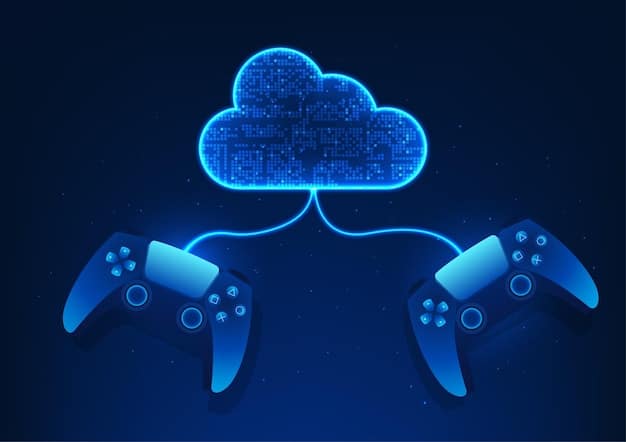Cloud Gaming’s Impact: How Will US Game Distribution Change by 2025?

The rise of cloud gaming services is poised to significantly reshape the US game distribution landscape by 2025, shifting from traditional physical and digital sales towards subscription-based streaming models, impacting developers, publishers, and consumer access to video games.
The gaming industry is on the cusp of a revolution, and the epicenter of this change is the cloud. The question isn’t if, but how will the rise of cloud gaming services reshape the US game distribution landscape by 2025? Let’s dive into the projections.
The Dawn of Cloud Gaming in the US
Cloud gaming is no longer a distant dream but a tangible reality, poised to disrupt traditional gaming models. The US market, with its advanced infrastructure and tech-savvy population, is ripe for cloud gaming’s transformative impact.
This shift is driven by the increasing accessibility of high-speed internet and the growing demand for gaming experiences that are both convenient and cost-effective. As we approach 2025, the influence of cloud gaming on the US game distribution landscape will become undeniable.
What is Cloud Gaming?
Cloud gaming, at its core, is streaming video games over the internet, similar to how Netflix streams movies. Instead of downloading and installing games on a local device, players access them remotely from powerful servers. This eliminates the need for expensive hardware and allows gaming on a variety of devices, including smartphones, tablets, and low-end computers.
Key Players in the US Cloud Gaming Market
Several major players are vying for dominance in the US cloud gaming market. Each platform offers unique features, game libraries, and subscription models. Key competitors include:
- Xbox Cloud Gaming: Leverages Microsoft’s extensive gaming ecosystem, offering access to a vast library of Xbox games through the Game Pass Ultimate subscription.
- GeForce Now: Allows players to stream their existing PC game libraries from various digital storefronts, such as Steam and Epic Games Store.
- PlayStation Plus Premium: Provides access to a curated collection of PlayStation games, including classic titles and newer releases.
- Amazon Luna: Offers a selection of game channels with different genres and price points, catering to a wide range of players.

The rise of these services is fueled by the convenience and accessibility they offer, attracting both hardcore gamers and casual players looking for an engaging gaming experience without the hefty upfront investment.
Impact on Traditional Game Distribution
The ascent of cloud gaming is set to challenge the established norms of game distribution in the US. The reliance on physical media and digital downloads will gradually diminish as cloud gaming becomes a more viable alternative.
This transition will have significant implications for retailers, publishers, and the overall structure of the gaming market.
Decline of Physical Game Sales
The shift towards digital distribution has already impacted physical game sales, and cloud gaming is expected to accelerate this trend. As more players embrace the convenience of streaming games, the demand for physical copies will continue to decline.
Challenges to Digital Download Platforms
While digital download platforms like Steam and PlayStation Store will remain relevant, they will face increased competition from cloud gaming services. The primary advantage of cloud gaming is the elimination of download times and storage requirements, which can be a significant pain point for many players.
New Revenue Models and Opportunities
Cloud gaming introduces new revenue models for publishers and developers. Subscription services, in-game purchases, and targeted advertising are becoming increasingly prevalent. This creates opportunities for innovative monetization strategies and deeper engagement with players.
The gaming industry is rapidly evolving, with cloud gaming leading the charge towards a more accessible and diverse gaming ecosystem. Traditional distribution methods will need to adapt to remain competitive.
The Developer’s Perspective
For game developers, cloud gaming presents both opportunities and challenges. The shift in distribution models requires developers to adapt their strategies for game development, marketing, and monetization.
Understanding the unique characteristics of cloud gaming is crucial for developers to thrive in this evolving landscape.
Optimizing Games for Cloud Streaming
Developing games for cloud streaming requires a different approach compared to traditional platforms. Factors such as input latency, network stability, and server performance become critical considerations. Developers need to optimize their games to ensure a smooth and responsive gaming experience on cloud platforms.
Expanding Reach and Accessibility
Cloud gaming allows developers to reach a broader audience by removing hardware barriers. Games can be played on a wider range of devices, making them accessible to players who may not have access to high-end consoles or PCs. This expands the potential market and creates opportunities for increased revenue.
Navigating New Monetization Strategies
Cloud gaming platforms offer various monetization options, including subscription revenue sharing, in-game purchases, and advertising. Developers need to understand these models and choose the most appropriate strategies for their games. Experimentation and data analysis are key to optimizing monetization in the cloud gaming environment.
- Focus on optimizing games for low latency and high performance.
- Offer a free-to-play or demo version to attract new players.
- Integrate in-game purchases and content updates to generate ongoing revenue.
The shift to cloud gaming requires developers to rethink their approach and embrace new strategies for success. Adapting to the unique demands of cloud platforms is essential for thriving in this dynamic market.
Impact on Gaming Hardware
One of the most significant implications of cloud gaming is its potential impact on the gaming hardware market. As more players opt to stream games, the demand for high-end consoles and PCs could decline.
This shift may lead to significant changes in the hardware manufacturing and retail industries.
Reduced Demand for Consoles and PCs
Cloud gaming eliminates the need for expensive gaming hardware, as games are processed on remote servers. Players can enjoy high-quality gaming experiences on a variety of devices, including smartphones, tablets, and low-end computers. This could lead to a decrease in demand for traditional gaming consoles and PCs.
Rise of Cloud-Optimized Devices
While the demand for high-end hardware may decline, there could be a rise in cloud-optimized devices. These devices are designed specifically for cloud gaming, offering a streamlined and affordable gaming experience. Examples include streaming sticks, smart TVs with built-in cloud gaming support, and lightweight laptops optimized for cloud gaming.
Implications for Hardware Manufacturers
Hardware manufacturers will need to adapt to the changing landscape. They may shift their focus towards cloud-optimized devices, develop cloud gaming platforms, or explore new business models that complement cloud gaming. Diversification and innovation will be crucial for hardware manufacturers to remain competitive in the cloud gaming era.

The hardware industry is preparing for a future where gaming is no longer tied to expensive consoles or PCs. As cloud gaming continues to evolve, the hardware landscape will adapt to meet the changing needs of players.
The Consumer’s Perspective
From the consumer’s point of view, cloud gaming offers numerous advantages, including convenience, accessibility, and cost savings. However, there are also potential drawbacks that need to be considered. Understanding the pros and cons of cloud gaming from the consumer’s perspective is essential for assessing its long-term viability.
The shift to cloud gaming may lead to significant changes in the way consumers access and enjoy video games.
Benefits of Cloud Gaming
Cloud gaming offers several benefits for consumers, including:
- Convenience: Play games on a variety of devices without downloads or installations.
- Accessibility: Access a wide range of games without expensive hardware.
- Cost Savings: Avoid upfront hardware costs and pay for gaming through subscription services.
- Instant Access: Start playing games instantly without waiting for downloads and updates.
Potential Drawbacks
While cloud gaming offers numerous benefits, there are also potential drawbacks:
- Internet Dependency: Requires a stable and high-speed internet connection.
- Latency Issues: Input lag and latency can impact the gaming experience.
- Limited Game Selection: Game availability may be limited depending on the cloud gaming platform.
- Subscription Costs: Ongoing subscription costs can add up over time.
Cloud gaming is poised to revolutionize the way consumers access and enjoy video games, offering unparalleled convenience and accessibility. However, addressing the challenges related to internet dependency and latency issues is crucial for widespread adoption.
Predictions for 2025
By 2025, cloud gaming will likely have established itself as a significant force in the US game distribution landscape. While it may not completely replace traditional methods, it will undoubtedly play a major role in shaping the future of gaming.
Several trends are expected to emerge as cloud gaming matures.
Increased Adoption of Subscription Services
Subscription services like Xbox Game Pass Ultimate and PlayStation Plus Premium will continue to gain popularity, offering access to vast libraries of games for a monthly fee. These services will become more attractive as cloud gaming improves and becomes more accessible.
Expansion of Cloud Gaming Infrastructure
Cloud gaming providers will invest in expanding their infrastructure to improve performance and reduce latency. This includes deploying more servers in strategic locations and optimizing network connectivity. The goal is to deliver a seamless and responsive gaming experience to players across the US.
Consolidation in the Cloud Gaming Market
The cloud gaming market may experience consolidation as larger players acquire smaller competitors or form strategic alliances. This could lead to a more concentrated market with fewer, more powerful players.
Key Aspect
Brief Description
🎮 Game Accessibility
Cloud gaming allows instant play on various devices, removing the need for downloads or expensive hardware.
📉 Hardware Impact
Traditional console and PC sales may decline as users shift to cloud-optimized devices.
💰 Subscription Models
Subscription services like Xbox Game Pass will dominate, offering diverse game libraries.
🌐 Infrastructure Development
Continued expansion of cloud gaming infrastructure is expected to enhance performance and reduce latency.
Frequently Asked Questions
▼
Cloud gaming is streaming games over the internet to various devices, like phones, tablets, and computers. Instead of downloading games, you play them remotely from servers.
▼
The primary advantages include accessibility on multiple devices, eliminating the need for expensive hardware, and instant access to games without long downloads.
▼
Cloud gaming may reduce the demand for high-end consoles and PCs as it offers gaming on more affordable devices. However, hardcore gamers may still prefer dedicated hardware.
▼
A stable and high-speed internet connection is essential. Most services recommend at least 25-50 Mbps for a smooth, high-quality gaming experience without excessive latency.
▼
Major players include Xbox Cloud Gaming, GeForce Now, PlayStation Plus Premium, and Amazon Luna. Each offers different game libraries and features for diverse player preferences.
Conclusion
As we approach 2025, the trajectory of the US game distribution landscape is undeniably intertwined with the growth of cloud gaming. While the complete displacement of traditional models is unlikely, cloud gaming’s increasing accessibility, convenience, and evolving technological advancements will undoubtedly reshape how games are distributed, developed, and consumed.





